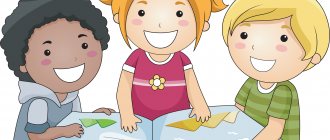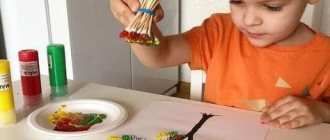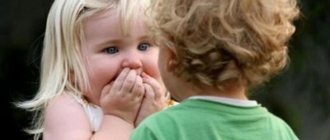Development of cognitive activity of preschool children
The youngest age of children - up to 5 years inclusive - is usually divided into 2 groups: the infant period and the preschool period. The first lasts from 0 to 3 years, and the second from 3 to 5.
As a rule, most schools and existing methods for developing the cognitive activity of preschoolers are designed specifically for this age period.
The study of child development differs significantly from research programs studying the activities of adolescents and adults. This can be clearly seen in the way the work is carried out and the methods of its implementation.
The main principle followed by the inventors of diagnostic programs is the principle of naturalness. It implies minimal interference from elders in the child’s everyday life.
Most often, a child’s cognitive activity is provoked in a playful way, which takes into account age-related developmental characteristics.
Various development scales are very popular and convenient to use, which provide for analytical and statistical observations with subsequent recording and comparison of activity data with age norms.
Working with scales requires specialized experience and should only be carried out under the supervision of seniors and a specialized psychologist. Therein lies a significant difficulty, because in the presence of a stranger, it is difficult for a child to show natural reactions to a stimulus. In this case, it is necessary to introduce active interaction between the teacher and psychologist.
The development of cognitive activity of preschoolers is a key direction in the education of preschoolers.
Boys are more likely to be active and learn about the world in the process. They can spend hours watching the operation of an excavator, a garbage disposal, or look into the driver's cab.
For them, the most relevant will be the stimulation of cognitive activity in the form of a live game. Only in this case will the knowledge be fully perceived and form the basis of the “imaginative” luggage. Girls are calmer and more persevering. For them, the “mother-daughter” game will be much more informative, which will gradually lay down the necessary knowledge for adult life. An art studio or music school will help develop a sense of beauty and give you a sense of self-worth.
Cognitive activity is in the blood of every child and is designed to help him adapt to life in the adult world. Gradually it transforms into a desire for knowledge and manifests itself in search games. The child will strive to gain new knowledge about the lives of older people and fresh impressions. With age, activity will develop into curiosity, which is so characteristic of the older generation.
In the early period of development, the emergence of a primary idea of the surrounding world occurs.
To form an image, all available means are used, which are inextricably linked:
- cognitive activity - perception of the world, thinking, imagination, memory, attention;
- emotional coloring - personal reaction to current events, surrounding objects and phenomena;
- the information obtained during the search process is knowledge and experience, both personal and of the older generation.
The child’s cognitive development is stimulated by a harmonious combination of the above stages. Educators and parents should help with this, not forgetting that a child’s cognitive process is fundamentally different from an adult’s.
An accomplished person perceives the surrounding reality from the point of view of the mind, and children - emotionally.
If for the former, facts are primary, and relationships and emotions are secondary, then for preschoolers the situation is exactly the opposite.
Correct formation of the development of adult thinking includes:
- knowledge - there are many secrets in the world that need to be revealed;
- frugality - the world is tender and fragile, it requires care and protection;
- creation - the world is beautiful and I want to pass it on and multiply it.
When planning cognitive development, you should remember the age-related characteristics of the child’s development.
The activity of a 3-year-old preschooler is based on a simple principle: I look, I act, I manipulate. This is how he experiences the world: he examines objects from all sides, tries, throws, feels.
With the help of simple actions, the child seeks answers to the basic questions “what, why, and why.” However, a 3-year-old preschooler cannot comprehend the hidden characteristics of an object on his own.
At the same time, children begin to draw the first parallels and cause-and-effect relationships, to perceive the meaning of the object and its role.
At the age of 3, it is best to direct cognitive activity in the direction of knowledge: organize interesting excursions and walks (in the garden, yard or small square), introduce them to pets, plants, and inhabitants of the aquarium.
Children of this age group love to receive gifts from nature: autumn leaves, sun rays, prickly snowflakes, pine cones, chestnuts.
It is very useful to hold informative celebrations - soap bubbles, paper crafts, flying seeds, butterfly wrappers.
This is where a respectful attitude towards the people around us and the “correct-help” connection is laid.
Cognitive activity is carried out all the time in one form or another, and not just in class, because is of enormous importance in the harmonious development of the child’s personality.
Individual conversations or group games, observing the world around us, solving riddles or simple puzzles, daily care for pets or a green corner - this is an incomplete list of educational activities.
By the age of 4, the body matures: physiological processes that change the cerebral cortex are activated, the nervous system is improved, the vocabulary and stock of impressions about the surrounding reality increase. During this period, the baby’s cognitive activity undergoes changes and moves to the next stage of development.
The child’s activities at this time are aimed at the path of discovery and accumulation of knowledge. The preschooler correctly perceives the information received verbally and learns to analyze it. This is what allows you to increase your child’s social circle and stop limiting yourself only to your close circle.
At the age of 5, a preschooler clearly and clearly perceives the surrounding reality, the store of knowledge and experience of previous years helps him in this. The main task of the adult generation during this period is to organize a subject-development environment to enhance cognitive activity.
Ways of understanding the world: verbal, auditory, kinetic, visual. Cognitive activity is aimed at obtaining new information; there is a desire to constantly expand horizons and look for additional sources of knowledge.
The degree of mental and intellectual development allows one to begin to become familiar with the categories “symbol, time, category.” Informative conversations, discussions of life situations, watched cartoons and videos, timely and correct answers to questions asked are welcome.
By the end of the “preschooler” age period, adults and educators should focus on organizing information according to any criterion, encouraging cognitive activity in the field of forming a positive picture about the world around them according to thematic blocks and areas of knowledge, and establishing cause-and-effect relationships.
In the preschool period, parents are faced with the question of determining their child’s abilities.
From a very young age, you can trace a child’s attraction to something, just watch him carefully - some dance, some draw, and some love to make things.
If you notice the preferences of a young person in time and take steps to develop abilities, then in adulthood you can get real talent.
The problem of correctly determining a child’s preferences arises quite acutely, because Not all parents are able to truthfully assess the achievements of their own child and often exaggerate them.
Educators and teachers of thematic circles, sections and studios can help with this. Sometimes a child can try them all until he finds the best leisure option for himself.
With proper development and a favorable environment, preschoolers grow into tireless optimists, inquisitive researchers, dreamers and thinkers. Help your children, guide their cognitive activity along the right path!
Thinking
The accumulation of knowledge does not lead to the development of thinking; it is formed only in active practical and cognitive activity. The development of a preschooler’s thinking goes through 3 stages and represents a complex interrelation of various forms of thinking:
- Visual-effective thinking (3–5 years). The main feature is the inextricable connection of thought processes with practical actions that transform the cognizable object. To think, you need to act with objects. For example, a child spins a toy, presses all the buttons, tries to open it, thus he “experiments and learns with his hands.” In the process of repeated actions with objects (and over a couple of years, hundreds and thousands of different objects will pass through the child’s hands), the child identifies their hidden characteristics and internal connections. Practical actions with objects become a means of understanding reality and form thinking.
- Visual-figurative thinking (4–6 years old) - the child begins to think not with specific objects with the help of his hands, but with their images and ideas, well imagining such objects. The child learns to cognize and solve problems in his mind, relying on his figurative ideas about objects, whereas before this he could only through practical actions. Now, in order for the child to find out which figure fits which hole, he does not need to insert them alternately, he can do this in his mind and quite quickly.
It is worth considering that a child is not always able to come to the correct answer through visual-figurative thinking.
His thinking may be strongly influenced by perception. If you show a child two absolutely identical and equal-in-volume balls of dough, and then in front of his eyes, turn one of the balls into a cake and ask where there is more dough, then the child will often declare that the amount of dough in the cake has increased. This thinking error is due to the fact that the child does not yet have the concept of volume and knowledge of other metric measurements. Visual models in which the properties and relationships of objects are reproduced are the most important condition for the formation of internal mental activity. For the emergence of imaginative thinking, imitation of an adult is also important. By reproducing the actions of an adult, the child builds internal models of actions that he plays out in role-playing games.
3. Logical thinking - begins to take shape towards the end of preschool age (about 7 years) and develops over many years, allowing the child to master the principles of logic. Such thinking is characterized by the fact that as a result the child operates with rather abstract categories and establishes various relationships that are not presented in visual form. However, at first, it is easier for the child to establish cause-and-effect relationships if a specific object is right in front of him and the changes occurring with it can be directly observed. Gradually he moves to thinking that is more abstracted from the current situation.
MAGAZINE Preschooler.RF
Formation of cognitive activity in preschool childrenKishaeva Tamara Petrovna, teacher Olga Vyacheslavovna Maturina, teacher Irina Nikolaevna Afanasyeva, teacher
GBOU secondary school No. 19, Novokuybyshevsk, joint venture "Kindergarten "Golden Key"
Tell me and I will forget, Show me and I will remember, Let me try and I will understand. Confucius
The development, upbringing, training, and education of preschool children are interconnected. A child grows and learns both when he plays alone, when he examines a stick or looks at a picture, and when, communicating with children, peers, younger or older children, he learns from them and passes on his own experience of activity - there is something for everyone learn from another.
Some activities seem meaningless to adults, but they are so only from the point of view of expediency, as adults understand it. For a child, they can be extremely important, vital. An adult, be it a teacher or a parent, constantly influences the child, forcing him to act in one way or another. By encouraging those ways of behavior that seem convenient for adults, they often ensure the safety of children, but do not support their initiative, limiting the scope of encouraged behavior, and do not give them the opportunity to express their individuality. For example, adults often forbid children to “experiment” only because they know in advance what the result will be and that it will not lead to anything useful.
Geniuses do not follow beaten paths, they find a problem where others do not notice it, they continue their path when no one is left with them. By forbidding a child to explore the world in his own way, adults are forbidding him to be a genius. Every child is, first of all, an individual who has the right to his own worldview and his own understanding of the world.
The experimentation method is an effective method of understanding the patterns and phenomena of the surrounding world. Depriving children of the opportunity to experiment and constant restrictions on independent activity in early and preschool age lead to serious mental disorders that last a lifetime and negatively affect the development and self-development of the child and the ability to learn in the future. Interest in research education for children is due to the high dynamism of the modern world, in which a person must be able to find non-standard ways to solve various life problems. The most valuable and lasting knowledge is not that which is acquired through learning, but that which is acquired independently. It is much more interesting for a child to study science by acting like a scientist than to receive knowledge in a ready-made form. A penchant for research is common to all children without exception.
The formation of cognitive activity in children can be seen in various forms of activity, including games, experimentation, observation of objects and phenomena. Children are natural explorers. This shows their curiosity, the desire to independently find solutions to a problem situation, and the desire to experiment. The task of adults is not to extinguish this activity, but to actively help its development. Cognitive - research activity and its form of experimentation are aimed at understanding the connections between the phenomena of the surrounding world, their ordering and systematization, the arrangement of things. Since he learns to distribute, arrange, classify, compare on several grounds (size, function, properties, etc.), the child’s intellectual abilities develop. Preschool children should be specifically introduced to the structure, purpose, and rules for using objects. The general components of studying a thing are its appearance (color, surface quality, size in three dimensions, planar and spatial filling, material, shape) associated with the purpose of the thing and its aesthetic value. The functioning of a thing can be considered in different planes: as a reflection of the purpose of the thing (what it was created for), as the compliance of the object with its purpose (how well it fulfills its duties - it corresponds to its purpose), as the ability to use it in additional functions (not for its intended purpose). or secondary).
Building classifications is the most important tool for the development of thinking in preschool age. From feature to row, from row to class, from a combination of features to their opposition - the child’s thought moves simultaneously with the comprehension of the external and internal essence of objects. It is very important here that the child tries to describe in words what is the difference between classes, what is the similarity of individual objects.
It is important not to miss the moment when the need for obtaining information, for “research” arises among the children themselves, when it can become a motive for collective distribution activities.
The child learns to see a problem, propose ways to solve it, evaluate them, adjust the work process, interact with peers and adults. In the process of implementing a plan, one gets to know oneself by clarifying one’s desire and one’s capabilities, the reflected phenomenon is deeply explored in material and spiritual terms, the properties of the materials used are learned, and the ability to select the necessary things for one’s work is developed.
The knowledge gained at earlier stages of understanding problems transforms into a new quality. Thus, the experience acquired by children in designing, drawing, working with musical instruments, singing, etc. organically integrates into new situations, where he acts as a support for solving other problems. Thus, we can say that research activity contributes to the development of both cognitive needs and creative activity, teaches independent search, discovery and assimilation of new things.
| Next > |



